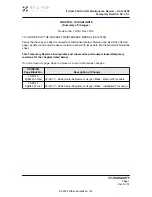
12.5 B-line stalls
A B-line stall with the eXCalibur is easy and performed as a normal descent technique. The pulling
down of the B-risers takes a lot of effort for the first 10cm, however the B-stall is easy to hold once
started. When ending the B-line stall you just have to let go of the risers quickly to avoid the glider
going parachutal.
12.6 Spiralling
Spiralling is the most efficient way to descend quickly. However, this causes a lot of strain for the
paraglider as well as the pilot. Please be aware that, according to your fitness, outside temperature
(cold) and descent rate, you could loose consciousness. Many pilots lower their breathing rate or
start hyper ventilating, both of which heighten the risk of loosing control.
With the first signs of sickness, weariness or blurred eye sight you must stop spiralling immediately.
Nearly every paraglider reaches the point where the canopy's leading edge points down (rolls over)
and may remain in this position even if the steering lines are let go deep spiralling.
The descent rate of the eXCalibur is 14m/sec as recorded by the DHV. You can achieve a higher
descent rate through slight braking of the outside wing without the eXCalibur rolling over. On rare
occasions a glider can drop into a deep spiral from a slow descent. The reason may be that the
pilot's weight is still focused on the inside of the turn after releasing the inner steering line.
A deep spiral can be stopped by shifting your weight to the middle and applying some counter
braking.
12.7 Big Ears
Big Ears is a simple, but not too effective way of descending. It is more suitable for reducing the
glider's performance. Too severe pull down of both sides reduces the speed but increases the risk of
a stall. You can increase the descent to approx. 5m/sec and halve the gliding performance.
Much greater stability, a higher sink rate and more forward speed will be obtained by also using
the accelerator. This can be a very useful and important strategy in some difficult situations.
DANGER:
Please note. You must
never
induce Big Ears when already on speed bar (accelerated), as
a front collapse is almost inevitable due to the already low angle of attack.
Always
apply Big Ears
first followed by the speed bar.
Please note:
Never attempt tight turns or spirals with Big Ears, as the A-lines will be over stressed.
12.8 Full stall
You can only induce a full stall by pulling the steering lines down by more than 65 cm and remaining
in this position for more than one second. When stall speed is reached the canopy will empty itself
at once, the pilot is hurled forward and the impression is given that the canopy falls backwards.
It is vital to keep the brakes pulled down until the empty canopy is above the pilot again (this will
take 3-6 seconds). If you let go of the steering lines with the paraglider still behind you, the glider
will shoot forward and dive in front. Not until the glider is above the pilot can the steering lines be
let go quickly and symmetrically. The perfect ending to a full stall should take place in two steps:
1) slow refilling of canopy (slow loosening of brakes, approx. up to the shoulder) until the canopy is
reopened completely, then
2) slowly releasing the brakes altogether
12.9 Negative Spins
Pulling down hard on one brake can cause the air stream to break away on that half of the wing. A
reversion of the air-stream direction can occur. The slowed half flies in the opposite direction. The
paraglider then turns around its vertical axis.
Please only attempt to induce negative spins under the instructions of an experienced trainer and
above water.
12.10 Wingovers
During severe so called wingovers the glider can be up to 90 degrees of angle (ie pilot out
horizontally). This is an illegal acrobatic flight manoeuvre and is prohibited. At up to 60 degrees of
angle the
eXCalibur
will not collapse if properly handled.
12.11 Emergency steering
In the event of loosing control of the steering lines, the eXCalibur can be flown easily with the rear
risers (D lines). A stall happens quicker when steering with the rear risers as opposed to steering
with the brake lines, being an average of approx. 20cm with the eXCalibur. Light turns can be flown
using the stabilo lines or by shifting your weight.
13. Summary
For a quick descent the best ways are B-stalls, spiralling and Big Ears. All other flight manoeuvres
are considered as artistic flying and just as dangerous. Full stall and spins are only to be flown over
water.
14. Care and storage
Your safety in the air depends on the condition of your paraglider. A maintained and properly used
paraglider will last a long time, In order to maintain your eXCalibur
’s
condition for a long time we
8
9
gliders for real pilots
independence
www.independence-world.com
gliders for real pilots
independence
www.independence-world.com



























